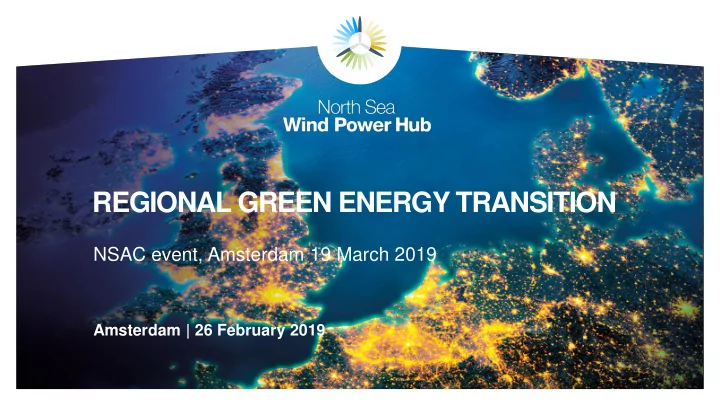

REGIONAL GREEN ENERGY TRANSITION NSAC event, Amsterdam 19 March 2019 Amsterdam | 26 February 2019
THE ENERGY FUTURE THAT WE ARE LOOKING INTO Perspective - power system ■ 80-95% reduction (compared to 1990) in CO2 emissions before 2050 ■ full decarbonisation of the electricity supply well before 2045 Bio Offshore wind (North Sea) Hydro Nuclear PV Offshore wind (other seas) Onshore wind ■ large scale, far offshore ■ flexibility to support non- ■ cross-border spatial ■ sufficient interconnection wind dispatchable generation planning capacity to maintain ■ accelerated deployment ■ minimum impact / maximum operational security benefit to environment NGO-meeting 18-3-2019 2
THE NORTH SEA WIND POWER HUB Developing large scale offshore wind power in the North Sea, to be supplied to European markets, using a modular “hub and spoke” concept • Offshore hubs in the North Sea could each connect up to approximately 30 GW wind power and distribute generated power to European markets through a network of cables (spokes) and/or pipelines (H 2 production) • From a hub, generated power will be transmitted to markets around the North Sea • The network of transmission cables will also function as interconnectors, directly connecting European energy markets North Sea Wind Power Hub Consortium TenneT Netherlands, TenneT Germany, Energinet, Gasunie and Port of Rotterdam joined forces to develop a large scale European energy system for offshore wind in the North Sea. Title of the presentation Month, Year 3
…MUCH MORE WIND IN THE NORTH SEA OFFSHORE WIND IS ESSENTIAL TO MEET PARIS ACROSS SCENARIOS 70 – 150 GW by 2040 Equals 7-15 times current installed capacity NGO-meeting 18-3-2019 4
NORTH SEA WIND POWER HUB PREFEASIBILITY PROJECT • Regional North Sea approach • Hub and spoke infrastructure concept • Wind power and interconnection combined • Integrating flexibility options (P2G/P2X)
NSWPH IS STANDING ON TWO LEGS Leg 1: Leg 2: North Sea International First Concrete Concept Coordinated Roll Out Source: NSWPH Concept Paper ‘The Vision’
HUB AND SPOKE VS BAU SEEN FROM ABOVE AC Radial DC Radial H&S
…AND FROM THE SIDE Business as usual Hub and spoke Large scale far from shore Far from shore Hub and spoke DC Close to shore platform AC > 80 km offshore platform
…AND IN TERMS OF SAVED INFRASTRUCTURE
THE NEED FOR AN INTEGRAL SPATIAL PLANNING APPROACH The large-scale offshore wind roll-out will impact the North Sea environment and Spatial will require cross-border cooperation Claims and co-utilization . ? To avoid delays in OWF deployment that would jeopardize meeting the Paris Environmental Public Agreement climate goals Concerns …the consortium is eager to initiate and facilitate discussions with policy makers, environmental organisations and Techno other relevant stakeholders Economic …and to contribute to these discussions by providing insight into the techno- economic and security of supply impacts of spatial planning choices North Sea Spatial Planning OWF Spatial Planning Cost Drivers 27 Sept 2018 10
KEY INSIGHTS FROM COST EVALUATION STUDY Hub & Spoke has 5-6% cost reduction potential • Limited area with relatively shallow • Near shore locations very attractive waters (<55m water depth) from LCOE perspective AC-radial only DC-radial only Hub and Spoke • • Sand mining areas has the highest • Higher LCOE in central Trench in central North Sea (>55m • spatial adaptation costs part of North Sea (deeper waters) water depth) Offshore Wind Cost Analysis February 2019 11
KEY STUDY INSIGHTS First indication on co-utilization costs show 1-2% increase of average LCoE Excluding nature areas will increase average LCoE of roll-out with approximately 3% Not all impacts of offshore wind area use are straightforward to monetize (e.g. long-term environmental effects) Most attractive locations (a.o): Borkum Riffgrund, Dogger Bank, Danish Coast, Norfolk Sandbanks Offshore Wind Cost Analysis February 2019 12
STUDY LIMITATIONS • France and Belgium are not included • Applied power density Higher power densities would allow for less spatial claim, but also (potentially) lower yield • No future decommissioning of oil & gas platforms Potentially increasing the remaining space for OWF development • Monopile foundation up to 55m water depth Applying different substructures will change cost input, hence the LCOE (experts argue impact is limited) • Floating turbines not considered Floating turbines can be deployed in deeper waters, increasing the remaining space for OWF development • Uncertainty on OWF wake losses Potentially overestimating the yield predictions for large clustered OWFs Offshore Wind Cost Analysis February 2019 13
WAY FORWARD Continued outreach to North Sea stakeholders Spatial Claims Provide techno-economic ? perspective in the spatial planning debate Environmental Public Concerns Three test areas being examined in deeper detail (based on study results) Techno Economic North Sea Spatial Planning OWF Spatial Planning Cost Drivers 27 Sept 2018 14
LOOKING A T THE WIDER NORTH SEA BY ANAL YSING DRIVERS AND DYNAMICS IN THREE EXPLORA TORY LOCA TIONS
THE LOCATIONS ARE EXPLORATORY This mean that the consortium: • does NOT yet consider itself in a position to make any decisions on spatial planning matters, • has NO preferred location yet, • is NOT developing a specific project yet, • has taken NO decision yet on any realization • is NOT in an environmental impact assessment process, • does NOT yet apply for permits. NGO-meeting 18-3-2019 16
MATURATION TIMELINE Mid 2019 2025-2030 2030-2035
NSWPH ORGANISATIONAL SETUP AND CONTACTS Main coordinator: Peter Godt-Larsen, team lead for the permits and legal work stream, plr@energinet.dk, +45 2491 7348. Country stakeholder managers/SPOC’s Denmark: Charlotte Melchiorsen, cme@energinet.dk, +45 3154 8414 Germany: David Scharte, david.scharte@tennet.eu, +49 151 527 632 26 The Netherlands: Henk van Bruggen, henk.van.bruggen@tennet.eu, +31 625 774 954 NGO-meeting 18-3-2019 18
Questions? Follow us on www.northseawindpowerhub.eu
Recommend
More recommend